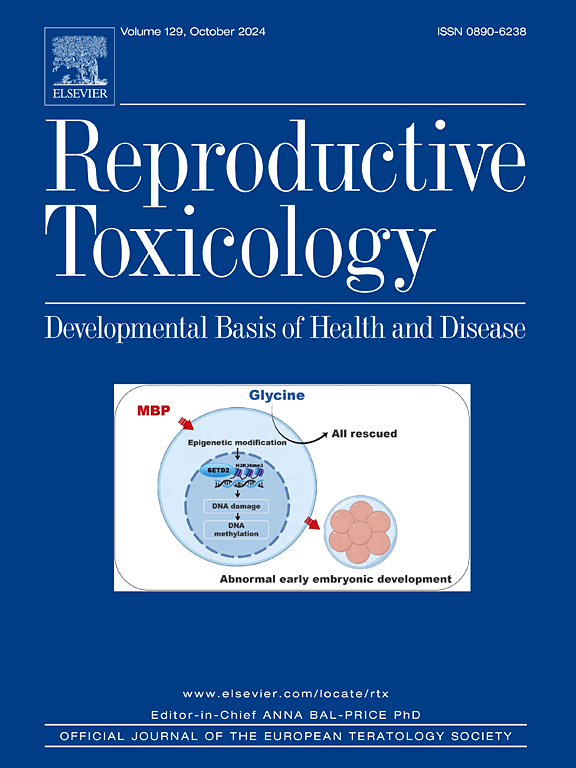双酚 A 诱导的氧化应激增加了小鼠卵巢癌干细胞的产生
IF 3.3
4区 医学
Q2 REPRODUCTIVE BIOLOGY
引用次数: 0
摘要
双酚 A(BPA)属于内分泌干扰化学物质(EDCs),会导致女性出现各种生殖障碍。我们分析了双酚 A 对子宫和卵巢的毒性作用。我们以瑞士小鼠为实验对象,按体重隔日重复给药低剂量(LD,1 毫克/千克)和高剂量(HD,5 毫克/千克)双酚A,连续给药 4 个月。在低剂量时,双酚 A 会降低体重、卵巢重量和大小,但在高剂量时会增加卵巢重量和大小。两个处理组的子宫重量、长度和直径都有所增加。组织病理学数据显示,卵巢卵泡体积减小、上皮增生和淋巴细胞浸润。经双酚 A 处理的子宫显示血管增生、子宫内膜和子宫肌层萎缩、子宫内膜增生(EH)并伴有异常腺体生长。根据抗小鼠 CD44 和抗小鼠 CD133 抗体的染色结果确定了卵巢中的癌症干细胞(CSCs),并用流式细胞术进行了分析。三种不同的卵巢癌干细胞群:根据CD44+CD133-、CD44+CD133+和CD44-CD133+这三种受体的强度,可以识别出这三种不同的卵巢干细胞群。CD44+CD133- 和 CD44+CD133+ 细胞的百分比在双酚 A 处理组中有所增加。CD44-CD133+ 在 LD 组中增加,但在 HD 组中减少。双酚 A 还会诱导 ROS 的产生,从而降低卵巢细胞中抗氧化基因超氧化物歧化酶 1(SOD1)、超氧化物歧化酶 2(SOD2)、过氧化氢酶(CAT)、谷胱甘肽过氧化物酶 1(GPX1)和叉头框 O3(FOXO3)的表达。总之,暴露于双酚 A 会诱发炎症反应、增加 CSC 的比例、诱发 ROS 并降低卵巢的抗氧化反应。本文章由计算机程序翻译,如有差异,请以英文原文为准。
Bisphenol A-induced oxidative stress increases the production of ovarian cancer stem cells in mice
Bisphenol A (BPA) belongs to the endocrine disruptor chemicals (EDCs) causing various reproductive disorders in females. We analysed the toxic effects of BPA in the uterus and ovaries. The BPA was administered orally with the repeated low dose (LD, 1 mg/kg) and high dose (HD, 5 mg/kg) of body weight on alternate days for 4 months via oral gavage to Swiss mice. BPA administration decreases body weight, ovarian weight and size at LD, but increases ovarian weight and size at HD. The uterus weight, length, and diameter were increased in both the treated groups. The histopathological data show decreased ovarian follicle size, epithelial hyperplasia, and lymphocytic infiltration in the ovary. The BPA-treated uterus shows increased vascularization, atrophied endometrium and myometrium, and endometrial hyperplasia (EH) with aberrant glandular growth. The cancer stem cells (CSCs) in the ovaries were identified based on staining with anti-mouse CD44 and anti-mouse CD133 antibodies and analysed by flow cytometry. Three different populations of ovarian CSCs: CD44+CD133-, CD44+CD133+, and CD44−CD133+, can be recognised based on the intensity of these receptors. CD44+CD133- and CD44+CD133+ cell percentages were increased in BPA-treated groups. CD44−CD133+ were increased in LD but decreased in HD. The BPA administration also induces ROS production, which decreases the expression of antioxidant genes Superoxide dismutase 1 (SOD1), Superoxide dismutase 2 (SOD2), Catalase (CAT), Glutathione peroxidase 1 (GPX1), and Forkhead box O3 (FOXO3) in ovarian cells. In conclusion, BPA exposure induced an inflammatory response, increased CSC proportions, induced ROS, and decreased antioxidant responses in the ovaries.
求助全文
通过发布文献求助,成功后即可免费获取论文全文。
去求助
来源期刊

Reproductive toxicology
生物-毒理学
CiteScore
6.50
自引率
3.00%
发文量
131
审稿时长
45 days
期刊介绍:
Drawing from a large number of disciplines, Reproductive Toxicology publishes timely, original research on the influence of chemical and physical agents on reproduction. Written by and for obstetricians, pediatricians, embryologists, teratologists, geneticists, toxicologists, andrologists, and others interested in detecting potential reproductive hazards, the journal is a forum for communication among researchers and practitioners. Articles focus on the application of in vitro, animal and clinical research to the practice of clinical medicine.
All aspects of reproduction are within the scope of Reproductive Toxicology, including the formation and maturation of male and female gametes, sexual function, the events surrounding the fusion of gametes and the development of the fertilized ovum, nourishment and transport of the conceptus within the genital tract, implantation, embryogenesis, intrauterine growth, placentation and placental function, parturition, lactation and neonatal survival. Adverse reproductive effects in males will be considered as significant as adverse effects occurring in females. To provide a balanced presentation of approaches, equal emphasis will be given to clinical and animal or in vitro work. Typical end points that will be studied by contributors include infertility, sexual dysfunction, spontaneous abortion, malformations, abnormal histogenesis, stillbirth, intrauterine growth retardation, prematurity, behavioral abnormalities, and perinatal mortality.
 求助内容:
求助内容: 应助结果提醒方式:
应助结果提醒方式:


